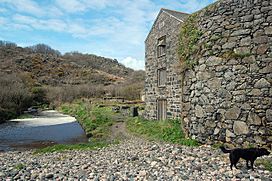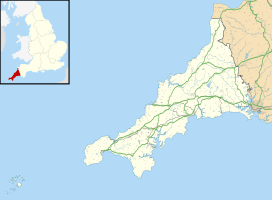Poltesco facts for kids
Quick facts for kids Poltesco |
|
|---|---|

Poltesco serpentine works, Cornwall
|
|
| Geography | |
| Country | England |
| State | Cornwall |
| Region | South West England |
| District | The Lizard |
| Map Ref: SW7216 | |
Poltesco is a small village and a beautiful valley located on the Lizard Peninsula in Cornwall, UK. The lower part of the valley is looked after by the National Trust. Long ago, it was a busy place where special stone was carved into amazing decorations. These were then sent all over Britain and even to other parts of Europe!
Contents
Discovering Poltesco's Nature
A stream called Poltesco flows from the southern part of Goonhilly Downs. It travels through the valley and finally reaches the sea at a spot called Carleon Cove. High up on the downs, you can still see the old ruins of the South Wheal Treasure copper mine. This mine was working in 1823. You can spot the walls of several large buildings, including a special engine house.
The Poltesco stream winds through a lovely wooded valley. It empties into Carleon Cove on the eastern side of the Lizard Peninsula. Just a short distance north-east is the sandy beach at Kennack Sands. About 1 km to the south-west is the charming village of Cadgwith.
The South West Coast Path, a famous walking trail, crosses the Poltesco stream right at Carleon Cove. This path follows the entire coast of south-west England. The Poltesco valley is part of the Cornwall Area of Outstanding Natural Beauty. It is also inside the Caerthillian to Kennack Site of Special Scientific Interest (SSSI). The many trees and shrubs make Poltesco special on the often windy Lizard Peninsula.
Poltesco's Past: Fishing and Stone
For hundreds of years, from the early 1300s to the late 1800s, Carleon Cove was a busy fishing spot. There was a big pilchard fishery here from the early 1700s to the early 1800s. Many of the old fishing buildings were later used by a factory that worked with a stone called serpentine.
The only sign left of the old fishing industry is a round, roofless building in the cove. This building once held a capstan, which was a machine used to pull fishing boats out of the water. You can still see a water mill and its mill pool on the southern side of the valley. These buildings were mostly built in the 1700s and 1800s, but might be even older. Inside, there's a carved figure that could be from the Middle Ages. The waterwheel you see today was built in the 1870s.
The Lizard Serpentine Company
People first wrote about carved serpentine stone in 1828. A man named Mr. Drew from Penzance carved serpentine in his free time while fixing the Lizard Lighthouse. He probably learned this skill from local people who had been doing it for a long time. Serpentine stone was used for houses, farm buildings, and even church towers in places like Mullion.
In 1846, Prince Albert and the royal family visited a serpentine workshop in Penzance. They were so impressed that they ordered mantelpieces and pedestals for their home, Osborne House, on the Isle of Wight. After The Great Exhibition in 1851, where millions saw products from all over the world, interest in serpentine grew even more.
The Lizard Serpentine Company built a factory at Poltesco in 1855. They later added more buildings, including a showroom, a warehouse, and offices. The factory walls were made of serpentine blocks, and the roof had clay tiles and slate. The company even had a showroom in London, where a very tall vase, about 2.3 meters high, was on display.
The stone came from local quarries by cart. The finished stone products were then taken by flat-bottomed boats to larger ships offshore. The company closed down in 1870 but was soon restarted as the Poltesco Marble Company.
Why the Serpentine Industry Ended
The new company, the Poltesco Marble Company, dropped the word 'serpentine' from its name. A new water wheel, built by Mr. Toy, was finished in 1881. According to The Cornishman newspaper, the large showroom was "well worth a visit" and was full of carvings of all kinds. However, by 1883, the factory had fewer workers, and the products were smaller.
Several things caused the industry to decline. The special serpentine rock needed for carving came from small areas. Finding large pieces without flaws became harder, which made the stone more expensive. Also, fashions changed, and serpentine was no longer as popular. It also didn't hold up well outside in the weather.
In 1893, the company closed for good because demand was falling. They also lost finished products at sea, which were not insured. Any valuable machinery was sold off, and the buildings were left empty. Today, walkers on the coastal path can see the remains of this old industrial site.
During the First World War, some buildings were used as a carpenter's workshop and a children's playroom. The water wheel was used until 1917 to prepare animal feed. Between the wars, there was a plan to turn the site into a holiday camp. Some parts of the factory were even blown up in 1923. Carleon House, which was leased to the manager Herbert Cohen in 1889, was bought by his daughter. She lived there until 1947. Today, the house and the valley are owned by the National Trust.
You can still see the remains of the serpentine works and the roofless capstan from the fishing days on the shore of Carleon Cove.


